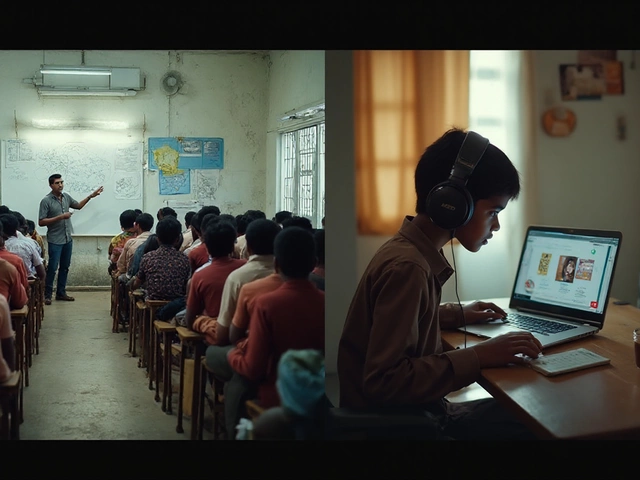
Coding seems like the golden ticket to a bright career, but what's often overlooked are the hurdles that come along with it. Frustration is a big one. Everyone hits a snag now and then, but in coding, snags can feel like brick walls. You might spend hours trying to fix a bug only to realize it was a missing semicolon. Ever felt like throwing your laptop out the window? You're not alone!
Then there's the question of time. Coding isn't something you can master overnight. It demands countless hours, and let's be honest, it can eat into your social life. You'll find yourself choosing between a night out with friends or wrestling with code that just won't work.
- The Frustration Factor
- Time Investment
- Isolation and Burnout
- Constant Learning Curve
- Debugging Nightmares
- The Pressure of Perfection
The Frustration Factor
Coding downsides aren't talked about as much as the thrilling part of creating new things. Yet, frustration is an integral part of every coder's journey. Imagine staring at your screen for hours because a line of code you’re convinced should work isn’t cooperating. Sound familiar?
The world of coding is littered with moments like these. Often, what seems like a tiny error—like a misplaced comma—can throw your whole code off. It’s a classic part of learning to code. You've got logic errors, syntax mistakes, and pesky bugs that seem to have minds of their own.
Debugging: A Love-Hate Relationship
Ah, debugging nightmares. You can’t escape them. A significant chunk of coding isn't just typing on your keyboard. It's figuring out why your code isn't working. Sounds fun, right? Think of it like solving a puzzle. Some days it can be rewarding; other times, it'll test your patience to the limits.
Here's a tip: Take regular breaks. When you’re staring down a stubborn piece of code, a short walk can provide a fresh perspective. Also, pair programming, where two programmers work together, can speed up this process. Two heads, they say, are better than one.
Managing Expectations
When starting out in coding classes, set realistic expectations. Coding is much like learning a new language. It takes mistakes (plenty of them) to get proficient. Celebrate small wins, even when it feels like you’re just moving an inch forward.
Finally, know that every developer, from newbie to pro, has been through frustration. It’s a universal experience. Embracing it as part of your learning curve will make the coding journey a lot more manageable.
Time Investment
If you've ever dabbled in coding, you know it's much more than just writing a few lines of code. It demands a significant time investment, and that's something every coder must reckon with. Whether you're just starting out or a seasoned pro, dedicating time is non-negotiable in this field. But what exactly are you investing your time in?
Learning the Basics
First off, you'll spend a good chunk of time just learning the basic concepts and syntax of your chosen programming language. It's like learning to speak a new language altogether. And just like speaking Italian or Mandarin, the more you practice, the more fluent you become.
Staying Current
Coding is not static; it's a field that's always evolving. A common estimate is that software knowledge becomes obsolete about every 18 months. This means coders need to continually learn new languages, frameworks, and libraries. It's not just about learning one language and sticking with it for life.
Project Time
Tackling projects can be a massive time drain as well. A simple app can take weeks of planning, coding, and testing. This is why many coding bootcamps or classes recommend setting aside at least 20-30 hours a week just for practice and projects. That's almost a part-time job in itself!
Real World Data
Let's look at a typical time breakdown for coding learners:
| Activity | Average Weekly Hours |
|---|---|
| Classes and Tutorials | 5-10 |
| Practice and Projects | 10-20 |
| Research and Staying Updated | 5 |
Remember, the key isn't just to invest time but to use it wisely. Focus on hands-on projects and real-world applications of what you're learning. This approach not only reinforces your learning but can also make the time spent more efficient and enjoyable.
Isolation and Burnout
Let's talk about a topic nobody likes to admit—coding can be an incredibly solitary pursuit. Imagine spending hours glued to your screen, buried in lines of code with only the hum of your computer to keep you company. This isolation is a downside that many people overlook when they first dive into coding classes.
When you're focused on solving complex problems, it's easy to lose track of time and disconnect from the world around you. This can lead to feelings of loneliness. A survey by GitHub highlighted that about 66% of developers often felt isolated due to the solitary nature of their work.
Recognizing Burnout
Burnout is another frequent visitor in the life of a coder. It creeps up on you when you've been coding non-stop, day in and day out. Symptoms include chronic fatigue, cynicism, and feeling ineffective.
How do you know when you're burning out? Here are some signs:
- Lack of enthusiasm for projects you once loved
- Constantly feeling exhausted, even after rest
- A drop in productivity and creativity
Tackling Isolation and Burnout
The good news? There are ways to combat these challenges. Finding a community, whether it's online forums or local coding meetups, can provide much-needed social interaction. Being part of a group where members share their coding downsides can make you feel less alone.
Taking frequent breaks and setting boundaries, like a fixed work schedule, can also help stave off burnout. It's crucial to give yourself permission to step away from the screen and recharge. Balance is key in any profession, and coding is no different.
Remember, acknowledging these downsides isn't a sign of weakness; it's part of developing a sustainable and enjoyable coding practice.

Constant Learning Curve
One thing folks might not tell you before diving into coding is how much you'll need to learn continuously. This isn't just about learning syntax; it's about keeping up with a landscape that changes faster than the Nairobi weather. New frameworks pop up, languages get updates, and technology progresses while you're still catching up.
Coding might feel like school never ends. Think you're finally done when you've mastered a programming language? Not quite. There's always a new version, a new library, a new something. Developers joke about it, but it's true: Your best friend could be Stack Overflow for much of your journey.
As tech guru Paul Ford puts it,
"Coding is a relentless quest to automate some of the most boring, tedious, repetitive things, and in doing so, create new boring, tedious, repetitive tasks."It's a loop of constant learning and adapting. You'll often find yourself in a love-hate relationship with this ongoing requirement to update your skills.
So, how do you manage this upslope? Here are a few things you can do:
- Subscribe to tech blogs and newsletters to stay updated.
- Partake in online courses and webinars. Websites like Coursera and Udemy offer a ton of resources.
- Join coding forums or local meetups. They give you a sense of community and help you learn from others.
When you're in the groove, the constant learning can feel exhilarating—it keeps the work interesting and your skills sharp. But beware the burnout that can come from trying to keep up with everything at once. The key is to find a balance that works for you.
Debugging Nightmares
Ah, debugging. The coding challenge that seems to have a vendetta against peace of mind. When people joke about code working in mysterious ways, they're often talking about the wild ride that is debugging. It's no wonder even seasoned developers sometimes feel like they're chasing their own tails.
First off, let's talk about the time investment debugging requires. Finding a single misplaced character can take minutes or hours, making it a huge thief of time. And that's not just frustrating—it's costly in a professional setting, where time really is money.
Why Debugging is So Tricky
Debugging is complicated because code often doesn't fail in a straightforward way. Look out for 'off-by-one errors'—a common mistake where loops don't execute as expected because the stopping condition is off by a single loop iteration. These can seem trivial but drive coders up the wall.
- Complex Dependencies: Sometimes, the bug isn't in your code but in one of the libraries or frameworks you're using—notoriously hard to pin down.
- Hidden Bugs: Bugs that don’t surface until you meet a specific condition in your code, making them particularly challenging to identify and fix.
- Environmental Issues: Problems that happen due to differences between development and production environments.
Tools and Techniques
If debugging feels like wandering through a forest at night, tools like IDEs (Integrated Development Environments) and debuggers act like flashlights illuminating the path. These tools have features to help highlight errors, trace code execution, and even suggest fixes.
| Tool Name | Purpose |
|---|---|
| Visual Studio Code | Integrated debugging, version control, and syntax highlighting. |
| GDB (GNU Debugger) | Debugging programs written in C, C++, and other languages. |
The best tip? Stay calm. Debugging is also about mindset. Every solved bug is a lesson learned. That’s how you move from wading through the mud to becoming a seasoned coder.
The Pressure of Perfection
Anyone who's dipped their toes into coding knows there's this unspoken pressure to get everything just right. As amazing as it is to piece together a functioning program, behind that satisfaction is the relentless quest for perfection—and let me tell you, it can be exhausting.
Think about this: when you're coding, even a tiny mistake can wreck the entire program. It's down to the last character, and there’s no safety net to catch you when things go south. That’s why so many devs spend late nights hunched over their screens, convinced they’ll get it right on the next try. But spoiler alert: there's always another layer of a problem to solve, which often leads to stress and, sometimes, burnout.
Why All the Fuss?
In the tech industry, the term “bug-free software” is thrown around a lot, yet it's practically a myth. Sure, you aim for it, but reality check: almost no large-scale software is completely bug-free. This pressure can be incredibly daunting for those just starting in coding classes.
| Coding Project | Bugs Discovered | Hours Spent Debugging |
|---|---|---|
| Website Development | 15 | 30 |
| Mobile App | 10 | 25 |
Take this data as a pinch of reality. Even seasoned developers face their fair share of headaches. The idea is not to write flawless code every time but to get better at handling what's thrown at you. It's about improvement, not perfection.
Chill Check: Dealing with Perfectionism
- Focus on learning from mistakes rather than avoiding them altogether.
- Set realistic goals. Small, achievable tasks can keep you motivated and prevent overwhelm.
- Remember that perfect is the enemy of good. It's better to have something functioning, even if it's not perfect, than nothing at all.
Understanding these ups and downs isn't meant to discourage. Rather, it's about preparing you to face the challenges head-on and not fall into the perfection trap. In the end, coding is as much about the journey as it is the destination.





